Taekwondo 태권도Taekwondo Preschool
When you reach senior belt you are expected to guide the junior belts when they are beginning Taekwondo such as showing by example. To advance from one rank to the next, students typically complete promotion tests in which they demonstrate their proficiency in the various aspects of the art before a panel of judges or their teacher. View Taekwondo belt levels »

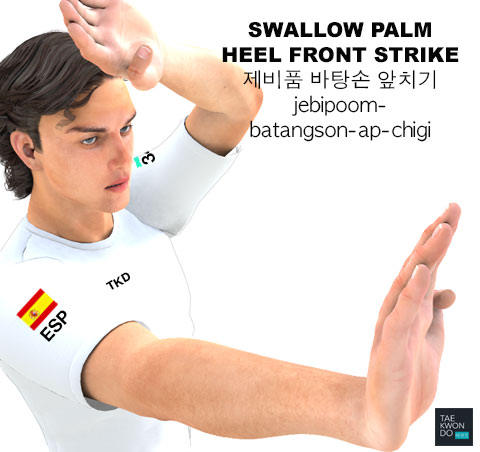


Swallow Palm Heel Front Strike
제비품 바탕손 앞치기 jebipoom-batangson-ap-chigi
Difficulty Level: Advanced Technique: Strikes ( 치기 chigi )
In the Korean martial arts taekwondo, Swallow Palm Heel Front Strike ( 제비품 바탕손 앞치기 jebipoom-batangson-ap-chigi ) is a strike where the hand is pulled back to engage with the base of the palm ( 바탕손 batangson ) in an upwards thrusting strike, while the other hand simultaneously blocks ( 막기 makgi ) upward with the Hand Blade Upward Block ( 손날 올려막기 sonnal-ollyeo-makgi ).
The intermediate level technique is both an offensive and defensive move at the same time and a technique that a practitioner should practice often and master. Practice is the act of rehearsing a behavior over and over, or engaging in an activity again and again, for the purpose of improving or mastering it, as in the phrase 'practice makes perfect'.
To perform the defensive move Hand Blade Upward Block ( 손날 올려막기 sonnal-ollyeo-makgi ), the blocking hand blade ( 손날 sonnal ) is set above the middle of the forehead to block ( 막기 makgi ) the head ( 머리 meoli ) from attacks such as the Hammer Fist Downward Strike ( 메주먹 내려치기 mejumeok-naeryeo-chigi ).
The Palm Heel Forward Strike ( 바탕손 앞치기 batangson-ap-chigi ) is particularly effective for striking the chin ( 턱 teog ), nose ( 코 ko ) and sternum ( 흉골 hyung-gol ) area. This is particularly dangerous if applied to the base of the opponent's nose ( 코 ko ) or chin ( 턱 teog ) that can result in death. This dangerous palm heel strike is obviously banned in competition sparring taekwondo.
The Swallow Palm Heel Front Strike ( 제비품 바탕손 앞치기 jebipoom-batangson-ap-chigi ) is not used in World Taekwondo (WT) sparring ( 겨루기 gyeorugi ) tournaments. It is an illegal technique to strike the face ( 얼굴 eolgul ) of the opponent during sparring competitions which could lead to a penalty ( 감점 gamjeom ) or warning ( 경 고 gyeong-go ) from the referee. The strike is performed commonly in patterns ( 품새 poomse ), self-defense ( 호신술 hosinsool ), one-step sparring, and demonstrations.
Strikes should generally be thrown with some measure of shifting body weight supporting the blow, as opposed to just the striking with the base of the palm ( 바탕손 batangson ). Strikes should aim for a point 4–6 inches (10–15 cm) behind the target surface, to impart the most energy into the target. The striker in combat should attempt to strike through the target area, not just contact the surface.
Variations
- Swallow Strike ( 제비품치기 jebipoom-chigi )
- Swallow Hand Blade Inward Strike ( 제비품 손날 안치기 jebipoom-sonnal-an-chigi )
- Swallow Palm Heel Front Strike ( 제비품 바탕손 앞치기 jebipoom-batangson-ap-chigi )
Training Methods
How well one improves with training depends on several factors, such as the frequency it is engaged in, and the type of feedback that is available for improvement. If a student does not train often enough, reinforcement fades, and he or she is likely to forget what was learned.
The strike is best learned initially striking at the air as though there is an opponent but focusing on the form, speed, and technique; then moving on to soft surfaces striking punch mitts and target pads. Large heavy bags are used more for strength and endurance, while smaller targets such as punch mitts and target pads focus on faster hand speed, timing and coordination. Target pads are useful for training mobility and accuracy on a moving target.
Difficulty of Technique
Taekwondo students of geup ranking learn the most basic techniques first, and then move on to more advanced and difficult techniques as they approach 1st Dan Black Belt. The more difficult the technique, the more practice may be needed for the purpose of improving or mastering it, as in the phrase 'practice makes perfect'. Every technique must display the requisite speed, balance, power and firmness to be realistically used as an attack or defense move.
* Please see a certified Master Instructor ( 사범님 sabeomnim ) for training. Proper guidance and instructions are needed to ensure safe training.
Promotion Tests
Students often undergo periodic testing and grading by their own Master Instructor ( 사범님 sabeomnim ) in order to advance to a higher level of recognized achievement such as a different belt color. They need to demonstrate their proficiency in the various aspects of the art such as the execution of patterns ( 품새 poomse ), which combine various techniques in specific sequences.
Swallow Palm Heel Front Strike ( 제비품 바탕손 앞치기 jebipoom-batangson-ap-chigi ) is a requirement for the below belt levels (Techniques vary between schools). Promotion from one belt level to the next can proceed rapidly in some schools, since schools often allow geup promotions every two, three, or four months. Students of geup rank learn the most basic techniques first, and then move on to more advanced techniques as they approach first dan black belt. View Promotion Tests »

Did you know?
Taekwondo Mental Toughness
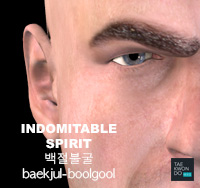

Mental toughness is very hard to explain through words and can truly be understood when put to the test in an intense situation where you feel like you are at a breaking point, and find an inner will within you to push forward and overcome the situation. There are those who face stressful situations and back down and let them trample them, these people crumble during life. Then there are those who when faced with stressful, energy draining situations take them by the horns and conquer them, and it fills you with such a great energy and confidence, that helps you with every obstacle that you have from there on. For more information View Mental Toughness »
Indomitable spirit ( 백절불굴 baekjul-boolgool ): To have indomitable spirit means to have the courage to stand up for what you believe in, no matter what odds you are up against, and to always give 100% effort in whatever you do.
Self-control ( 극기 geuk-gi ): This means to not only have control over one's physical acts, but also their mental thoughts and actions.
Perseverance ( 인내 in-nae ): One will persevere time and time again until they have achieved a result which is adequate towards what one was trying to achieve.
RESOURCES
This article uses material from the Wikipedia articles "Mental Toughness" and "International Taekwondo Federation Philosophy" which is released under the Creative Commons Attribution-Share-Alike License 3.0.
Advertisement
Swallow Palm Heel Front Strike ( 제비품 바탕손 앞치기 jebipoom-batangson-ap-chigi )
Striking Surface
Various surfaces of the hand may be engaged as the striking surface depending on which area of the opponents body which is being targeted. This leads to a large array of hand positions. For more information on Impact Surface Areas »
( Click image for additional information)
Suitable Targets
Experienced strikers learn through repetition and muscle memory when (not just how) to launch particular strikes, based on the circumstances they are facing. Focus helps in achieving proper penetration and in maximizing the damage at the point of impact to the area of the opponents body which is being targeted. For more information on Impact Surface Areas »
( Click image for additional information)
Technique Injuries
Collisions with the ground, objects, and other taekwondo practitioners are common, and unexpected dynamic forces on limbs and joints can cause injury. Taekwondo injuries can also occur in techniques if done improperly or from overuse of a particular body part. Taking a break from training or reducing the volume and the intensity of the training will allow the body to recover. For more information on Injuries »
( Click image for additional information)
Common Mistakes when Performing the Technique
When performing the technique, there will be more mistakes as a beginner and as the practitioner advances through the rankings, they will have learned and improved from the past. How well one improves with training depends on several factors, such as the frequency it is engaged in, and the type of feedback that is available for improvement.
( Click image for additional information)
Some Combination Techniques after the Strike
After striking with the technique, the taekwondo practitioner may immediately combination strike again to the opponent with a kick ( 차기 chagi ) or punch ( 지르기 jireugi ). When the opponent is being attacked, they may be vulnerable recovering from the initial blow, strategic positioning by the attacker to gain advantage, imbalance by defender, and many more factors. Practitioners may combine techniques in a series to ensure one or more strikes impact their opponents.
( Click image for additional information)
Some Stance(s) ( 서기 sogi ) used with the Strike
An example of the union of mental and physical discipline is the combination of stance ( 서기 sogi ), footwork ( 딛기 ditgi ), and technique (either with kick, block and/or strike), which requires both physical mastery of the technique and the concentration to focus one's power. Experienced practitioners learn through repetition and muscle memory when (not just how) to launch particular techniques, based on the circumstances they are facing.
( Click image for additional information)
Swallow Palm Heel Front Strike ( 제비품 바탕손 앞치기 jebipoom-batangson-ap-chigi )
Use in Sparring ( 겨루기 gyeorugi )
Under World Taekwondo (WT) and Olympic rules, sparring is a full-contact event and takes place between two competitors in an area measuring 8 meters square. A win can occur by points, or if one competitor is unable to continue (knockout) the other competitor wins. Points are awarded for permitted, accurate, and powerful techniques to the legal scoring areas; light contact does not score any points. For more information on World Taekwondo (WT) Tournament Sparring » 
The Swallow Palm Heel Front Strike ( 제비품 바탕손 앞치기 jebipoom-batangson-ap-chigi ) is not used in World Taekwondo (WT) Sparring ( 겨루기 gyeorugi ) tournaments. It is an illegal technique to strike the face of the opponent during sparring competitions which could lead to a penalty or warning.
Penalties on any prohibited acts shall be declared by the referee. Penalties are divided into Warnings ( 경 고 gyeong-go ) and Deduction Penalty ( 감점 gamjeom ). The technique is more suited for Self-Defense ( 호신술 hosinsool ) usage. For more information on Prohibited Acts and Penalties »
( Click image for additional information)
Use in Self-Defense ( 호신술 hosinsool ) Applications
Self-Defense is to protect yourself from being attacked from would-be aggressors. It is a countermeasure that involves defending the health and well-being of oneself from harm and is designed primarily to cause injury or quickly incapacitate an attacker, in addition to being a deterrent against them. Attackers are typically larger, stronger, and are often armed or have an accomplice. With proper execution attackers may be incapacitated with a single blow, which lessens the number of attacks with multiple people. For more information on Self-Defense ( 호신술 hosinsool ) »
Each technique must be correctly timed and aligned in order to defend effectively. Practitioners must have their body weight correctly distributed during the stance ( 서기 sogi ) including proper footwork ( 딛기 ditgi ). The strike is commonly performed during Self-Defense ( 호신술 hosinsool ) scenarios.
( Click image for additional information)
The self-defense ( 호신술 hosinsool ) applications would be difficult to score in sparring ( 겨루기 gyeorugi ) as they are designed primarily to cause injury or quickly incapacitate an adversary. Suitable targets for self-defense are less restrictive than sparring competitions and offers more areas to strike the opponent. An illegal technique in sparring competitions could lead to a penalty ( 감점 gamjeom ) or warning ( 경 고 gyeong-go ) but not in self-defense.
( Click image for additional information)
Use in One-Step Sparring
One-Step Sparring is performed with a partner in which predefined movements are practiced. One student is the attacker while the other student responds with defenses, counterattacks, and/or other actions, based on part of the predefined movements. For more information on One-Step Sparring »
The strike is commonly featured during One-Step Sparring practice. Fundamentally, taekwondo One-Step Sparring is one of the learning grounds for real combat. As such, every technique including stance ( 서기 sogi ) must display the requisite speed, power and firmness to be realistically used as an attack or defense move. One-Step Sparring varies between schools.
( Click image for additional information)
Use in Breaking ( 격파 gyeokpa )
The discipline of destroying inanimate objects such as wooden boards, baseball bats, ice blocks or cement bricks and is a feature common to martial arts including taekwondo. A single board or stack of boards may be broken or, alternatively, a series of boards may be broken in a pre-set sequence utilizing a variety of strikes. Advanced competitors may even break several boards in a single jump with multiple kicks before landing. For more information on Breaking ( 격파 gyeokpa ) »
In use, the strike is not featured during Breaking ( 격파 gyeokpa ) events. General qualities that judges look for in any taekwondo practitioner include proper breathing technique and body control. The diaphragm must be engaged in deep breathing, shallow breathing concentrated in the upper abdomen results in raised shoulders and stressed muscles. Breaking ( 격파 gyeokpa ) varies between schools.
( Click image for additional information)
Swallow Palm Heel Front Strike ( 제비품 바탕손 앞치기 jebipoom-batangson-ap-chigi )
Use in Patterns ( 품새 poomse )
Strike is introduced in the following patterns:
PALGWE #: 6
Poomse is the foundation for the teaching of taekwondo. A poomse or form is a detailed pattern of defense-and-attack motions and techniques used in traditional martial arts. Poomse is useful in developing proper kinetics, mental and physical fortitude.
( Click image for additional information)
Most Kukkiwon 국기원 schools will use the poomse taegeuk whereas a few schools will use the poomse palgwe. The meanings, trigrams and symbols are shared by both poomse taegeuk and poomse palgwe, however the sequence of movements is different. The first 8 forms of the set of poomse differ from each other, whereas the last 9 forms (Black Belt forms) of the set are shared between the two sets. All students studying in World Taekwondo (WT) Kukkiwon style must learn these forms, or taegeuk, to advance to a higher belt level. There are eight taegeuk forms, each one similar to the previous one, but each time with more complicated techniques to display the students' mastery of the techniques learned during lessons, as well as the ability to interconnect these techniques.
For more information on taekwondo patterns refer to Poomse 품새 Section »
Learn other taekwondo strikes on the Main Strikes Section »
Use in Demonstrations
To promote taekwondo for its emphasis on high kicking and fast hand techniques, taekwondo schools perform at tournaments, community events, shopping malls, parks, and tv shows. Demonstrations vary from school to school, but may include such elements as the execution of poomse ( 품새 poomse ), which combine various techniques in specific sequences; the breaking of boards to demonstrate the ability to use techniques with both power and control; sparring ( 겨루기 gyeorugi ) and self-defense ( 호신술 hosinsool ) to demonstrate the practical application and control of techniques; physical fitness usually with push-ups and sit-ups. For more information on Demonstrations »
The strike is commonly used in demonstration activities such as when performing poomse ( 품새 poomse ) which is the foundation for the teaching of taekwondo. A poomse ( 품새 poomse ) is a series of movements linked together in a prescribed sequence which is significant to demonstrate. As such, every technique must display the requisite speed, power and firmness to be realistically used as an attack or defense move.
( Click image for additional information)
Use in Warming-Up
A warm-up generally consists of a gradual increase in intensity in physical activity, joint mobility exercise, and stretching, followed by the activity. Warming-up brings the body to a condition at which it safely responds to nerve signals for quick and efficient action. For more information on Warming-Up »
In addition to being a strike in itself, the strike is an exercise used by many instructors to teach the principle of focusing, stretching, relaxing the muscles, increasing the range of motion and flexibility, something which is considered important in taekwondo. The result is a feeling of increased muscle control, flexibility and range of motion.
( Click image for additional information)
Swallow Palm Heel Front Strike ( 제비품 바탕손 앞치기 jebipoom-batangson-ap-chigi )

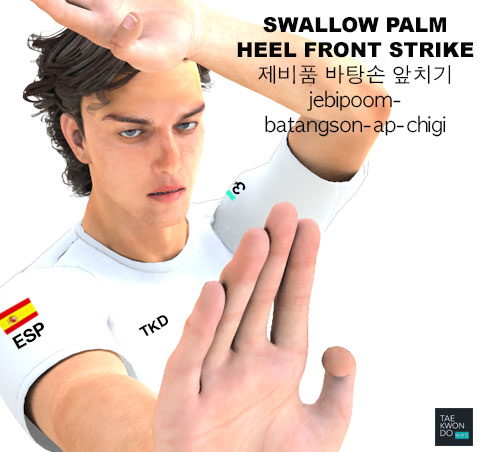
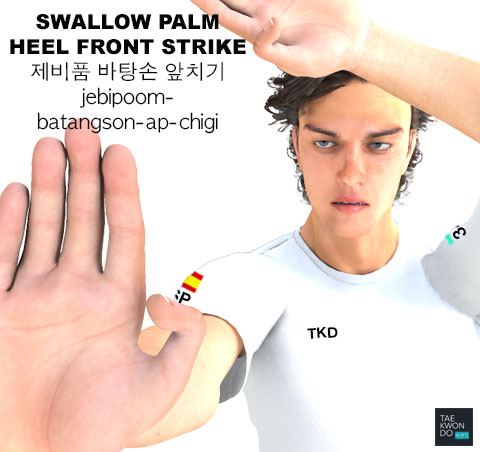
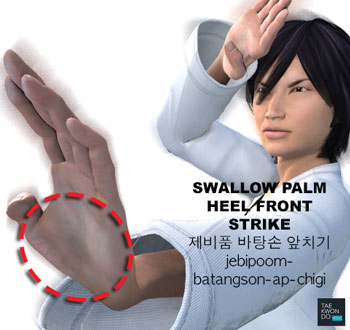

Training Highlights Summary
The Strike contains many key point highlights. There are some that are simple and straightforward but then some are complex and detailed that require repeated training to learn and master.
- engage the base of the palm ( 바탕손 batangson ) in an upwards thrusting strike while blocking upward with the other hand
- the palm strikes hit with the bottom part of the palm ( 바탕손 batangson )
- block upward with Hand Blade Upward Block ( 손날 올려막기 sonnal-ollyeo-makgi ) and strike with Palm Heel Forward Strike ( 바탕손 앞치기 batangson-ap-chigi )
- strikers may combine techniques in a series to ensure one or more strikes impact their opponents
Strength Requirement of the Technique
Most strikes should generally be thrown with some measure of shifting body weight supporting the blow. The striker in combat should attempt to strike through the target area, not just contact the surface. Some strikes do not need as much strength as they target vulnerable areas such as the eyes ( 눈 nun ), neck ( 목 mok ) or sternum ( 흉골 hyung-gol ). The below is an approximate measurement of how much strength the strike requires from the practitioner to be effective.
Precision of Striking Technique
With proper execution opponents may be incapacitated with a single striking blow, which lessens the number of further strikes. Some techniques can strike with more precision which will often cripple or knockout the opponent. The below is an approximate measurement of how precise the strike requires from the practitioner to be effective.
Experienced practitioners learn through repetition and muscle memory when (not just how) to launch particular strikes, based on the circumstances they are facing.
* Please see a certified Master Instructor ( 사범님 sabeomnim ) for training. Proper guidance and instructions are needed to ensure safe training.
Advertisement

Quiz
Question. What is the korean terminology for Attention Stance?
Attention is a stance ( 서기 sogi ) where your body is in an upright standing position with the legs side by side, heels touching, distribute 50/50 weight ratio on the left and right legs, and toes facing straight forward. Your hands should be parallel with your body, to the side as your hands tap the legs.
What is the korean terminology for Attention Stance?
Answer you gave was: ( 그만 keu-man )
Your answer is wrong! You need to study more!
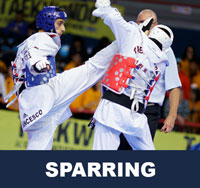

Keu-man ( 그만 ) means to stop a sparring match or poomse. Sparring is a full-contact event and takes place between two competitors in an area measuring 8 meters square. A poomse or form is a detailed pattern of defense-and-attack motions and techniques used in traditional martial arts. Poomse is the foundation for the teaching of taekwondo.
View Korean Terminology »
What is the korean terminology for Attention Stance?
Answer you gave was: ( 차렷 charyeot )
Your answer is correct! Great Job!
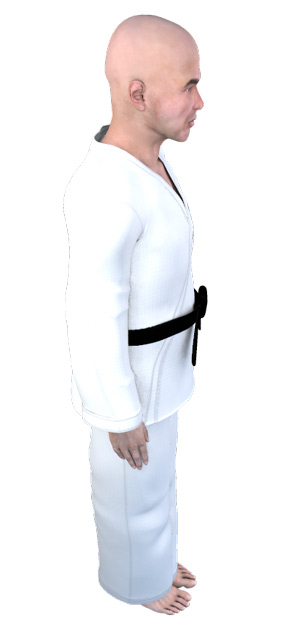

Attention is a stance where your body is in an upright standing position with the legs side by side, heels touching, toes facing straight forward. From this stance instructors explain what will be taught during the class session and/or if they want your attention they say Charyeot, meaning you stop whatever you are doing and get into the stance awaiting further instructions. This is the stance ( 서기 sogi ) that all bows ( 경례 gyeong-nye ) come from and is one of the most basic techniques to learn when starting taekwondo as a beginner.
What is the korean terminology for Attention Stance?
Answer you gave was: ( 기합 kihap )
Your answer is wrong! You need to study more!
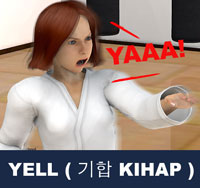

Kihap 기합 is a korean term used in taekwondo which is commonly referred to as a shout or yell made before, during, or after a technique. There are numerous examples of this battle cry in other martial arts: kihap is perhaps primarily a development of this. Students also use kihap to startle an opponent, intimidate, express confidence, or express victory in sparring competitions, self-defense ( 호신술 hosinsool ), or breaking ( 격파 gyeokpa ) applications.
View Yell ( 기합 kihap ) »
What is the korean terminology for Attention Stance?
Answer you gave was: ( 경례 gyeong-nye )
Your answer is wrong! You need to study more!
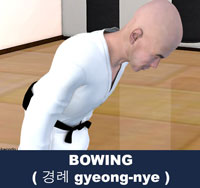

Bowing ( 경례 gyeong-nye ) is the act of lowering the torso and head as a gesture in direction to another person (Master Instructor 사범님 sabeomnim ) or symbol (flag). Bowing is an integral part of traditional martial arts such as Taekwondo. Bows are used to begin and end practice, sparring bouts and competitions, and when entering and leaving the dojang, or practice room.
Question. What year was Taekwondo an official Olympic Demonstration Sport in Seoul, Korea?
Taekwondo made its first appearance at the Summer Olympic Games as a demonstration sport at the Summer Olympics in Seoul, South Korea. The opening ceremony featured a mass demonstration of taekwondo with hundreds of adults and children performing moves in unison. Taekwondo was again a demonstration sport at the Summer Olympics in Barcelona, Spain. There were no demonstration sports at the Summer Olympics in Atlanta, USA.
What year was Taekwondo an official Olympic Demonstration Sport in Seoul, Korea?
Answer you gave was: 1992
Your answer is wrong! You need to study more!


In 1982, taekwondo was designated an official demonstration sport for the 1988 Olympic Games in Seoul, Korea, and for the 1992 Olympic Games in Barcelona, Spain. Taekwondo made its first appearance at the Summer Olympic Games as a demonstration sport at the 1988 Summer Olympics in Seoul, South Korea. The opening ceremony featured a mass demonstration of taekwondo with hundreds of adults and children performing moves in unison.
View Olympic Games »
What year was Taekwondo an official Olympic Demonstration Sport in Seoul, Korea?
Answer you gave was: 1988
Your answer is correct! Great Job!


In 1982, taekwondo was designated an official demonstration sport for the 1988 Olympic Games in Seoul, Korea, and for the 1992 Olympic Games in Barcelona, Spain. Taekwondo made its first appearance at the Summer Olympic Games as a demonstration sport at the 1988 Summer Olympics in Seoul, South Korea. The opening ceremony featured a mass demonstration of taekwondo with hundreds of adults and children performing moves in unison.
View Olympic Games »
What year was Taekwondo an official Olympic Demonstration Sport in Seoul, Korea?
Answer you gave was: 2000
Your answer is wrong! You need to study more!


In 1982, taekwondo was designated an official demonstration sport for the 1988 Olympic Games in Seoul, Korea, and for the 1992 Olympic Games in Barcelona, Spain. Taekwondo made its first appearance at the Summer Olympic Games as a demonstration sport at the 1988 Summer Olympics in Seoul, South Korea. The opening ceremony featured a mass demonstration of taekwondo with hundreds of adults and children performing moves in unison.
View Olympic Games »
What year was Taekwondo an official Olympic Demonstration Sport in Seoul, Korea?
Answer you gave was: 1996
Your answer is wrong! You need to study more!


In 1982, taekwondo was designated an official demonstration sport for the 1988 Olympic Games in Seoul, Korea, and for the 1992 Olympic Games in Barcelona, Spain. Taekwondo made its first appearance at the Summer Olympic Games as a demonstration sport at the 1988 Summer Olympics in Seoul, South Korea. The opening ceremony featured a mass demonstration of taekwondo with hundreds of adults and children performing moves in unison.
View Olympic Games »
Question. What is the korean terminology for Low Block?
The Low Block is one of the most basic Taekwondo blocks ( 막기 makgi ) and one of the first things a beginner will learn. The lead forearm is bent and raised to shoulder height, snapping the arm straight down with the palm ( 손바닥 sonbadak ) facing the ground, which blocks any incoming low kicks ( 차기 chagi ) or low strikes.
Question. What is the korean terminology for Low Block?
Answer you gave was: ( 아래막기 arae-makgi )
Your answer is correct! Great Job!

The Low Block ( 아래막기 arae-makgi ) is one of the most basic Taekwondo blocks ( 막기 makgi ) and one of the first things a beginner will learn. The lead forearm is bent and raised to shoulder height, snapping the arm straight down with the palm ( 손바닥 sonbadak ) facing the ground, which blocks any incoming low kicks ( 차기 chagi ) or low strikes.
Question. What is the korean terminology for Low Block?
Answer you gave was: ( 바깥막기 momtong bakkat makgi )
Your answer is wrong! You need to study more!

An Outside Middle Block ( 바깥막기 momtong-bakkat-makgi ) deflects a strike away from the defender leaving an opportunity for a counterattack. For example, against a straight punch ( 지르기 jireugi ) to the chest area, an Outside Middle Block would aim to meet the forearm of the attacker, pushing the punch outwards causing it to miss, and then most commonly leaving the defender slightly to the side to counterattack the opponent.
Question. What is the korean terminology for Low Block?
Answer you gave was: ( 몸통막기 momtong makgi )
Your answer is wrong! You need to study more!

An inside Middle Block ( 몸통막기 momtong-makgi ) deflects a strike away from the defender and away from the attacker. For example, against a straight punch ( 지르기 jireugi ) to the face, an inside forearm block would aim to meet the inside of the forearm of the attacker, pushing the punch ( 지르기 jireugi ) outward, leaving the opponent open for a counter attack.
Question. What is the korean terminology for Low Block?
Answer you gave was: ( 올려막기 olgul makgi )
Your answer is wrong! You need to study more!

The High Block ( 올려막기 olgul-makgi ) deflects a downward strike such as a Hammer Fist Downward Strike ( 메주먹 내려치기 mejumeok-naeryeo-chigi ), a stick attack from above, a face punch from a taller opponent, or possibly a kick like the Axe Kick ( 내려차기 naeryeo-chagi ). The blocking arm starts low with the hand in a relaxed fist ( 주먹 jumeok ) across the abdomen (over the belt) with the palm ( 손바닥 sonbadak ) facing upward.
Question. What is the korean terminology for Walking Stance?
The Walking Stance is a beginner stance ( 서기 sogi ) that is used to approach or retreat in combat and poomse. Feet should be maintained approximately 3 foot-length from origin. To maintain a solid base, the front foot is facing straight forward and the back foot is 30 degrees to aid balance.
Question. What is the korean terminology for Walking Stance?
Answer you gave was: ( 주춤서기 juchum sogi )
Your answer is wrong! You need to study more!

The Horse-Riding Stance ( 주춤서기 juchum-sogi ) is a beginner stance ( 서기 sogi ) generally used to practice punches ( 지르기 jireugi ) and blocks ( 막기 makgi ). It is similar to the Ready Stance ( 기본준비 junbi ) but the feet are placed much wider, about two-foot length's apart. Also, the knees ( 무릎 mureup ) are deeply bent and the shins ( 정강이 jeonggangi ) should be kept slightly perpendicular to the floor.
Question. What is the korean terminology for Walking Stance?
Answer you gave was: ( 기본준비 junbi )
Your answer is wrong! You need to study more!

Ready Stance ( 기본준비 junbi ) is performed by standing with the feet one foot-length from origin apart, measured from the inside edge or namely the Reverse Foot Blade ( 발날등 balnaldeung ) of the feet. The arms are slightly bent and the fists held tightly about one fist size apart just below the belly button and the fists should be a fist size away from the body. The stance ( 서기 sogi ) is one of the most important techniques to learn when starting taekwondo as a beginner.
Question. What is the korean terminology for Walking Stance?
Answer you gave was: ( 앞굽이 ap kubi )
Your answer is wrong! You need to study more!

Front Stance ( 앞굽이 ap-kubi ) is one of the most important techniques to learn when starting taekwondo as a beginner. The distance between the inside edges or namely the Reverse Foot Blade ( 발날등 balnaldeung ) of both feet should be between one to two fists apart and is about 4 to 4 one-half foot-length from origin. Rear toes are turned outward about 30 degrees and the body is also naturally angled at 30 degrees or facing straight forward depending on the upper body technique.
Question. What is the korean terminology for Walking Stance?
Answer you gave was: ( 앞서기 ap sogi )
Your answer is correct! Great Job!

The Walking Stance ( 앞서기 ap-sogi ) is a beginner stance ( 서기 sogi ) that is used to approach or retreat in combat and patterns ( 품새 poomse ). Feet should be maintained approximately 3 foot-length from origin. To maintain a solid base, the front foot is facing straight forward and the back foot is 30 degrees to aid balance. Use of this stance ( 서기 sogi ) is featured prominently in many of the World Taekwondo (WT) Poomse.
Additional Resources
Taekwondo Strikes ( 지르기 jireugi )
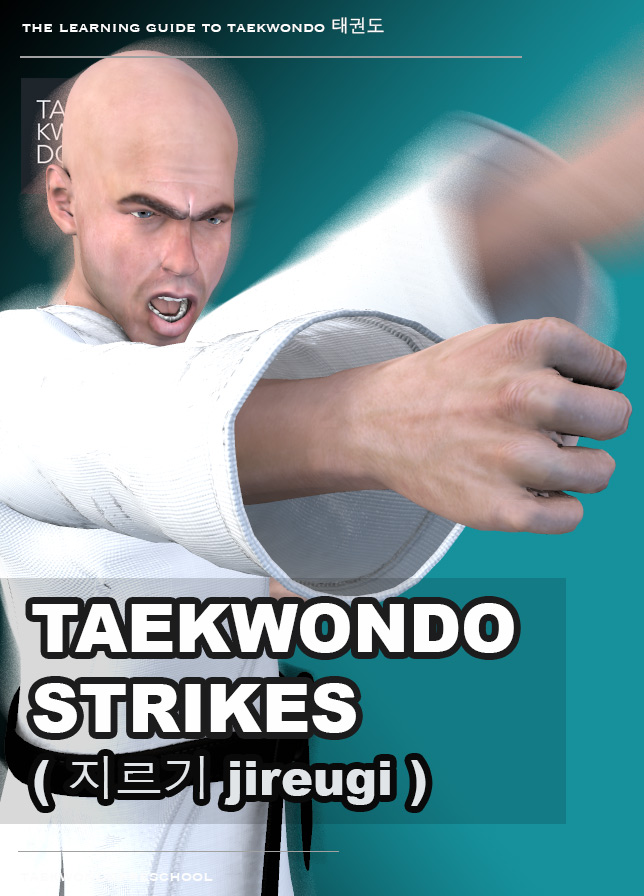
This book is available for download with Apple Books on your Mac or iOS device, and with iTunes on your computer. Book can be read with Apple Books on your Mac or iOS device.
Various surfaces of the hand ( 손 son ) may be engaged as the striking surface depending on which area of the opponents body is being targeted. Striking ( 치기 chigi ) are taekwondo techniques striking with the twisting force of the body excluding techniques using the fist ( 주먹 jumeok ) or fingertips ( 손끝 sonkkeut ). Thrusting ( 찌르기 Jjireugi ) are techniques striking with the fingertips ( 손끝 sonkkeut ). Chopping ( 찍기 Jjikgi ) are techniques striking with curled fingers. This leads to a large array of hand positions and taekwondo also makes use of reverse and front elbow strikes ( 팔굽 치기 palgup-chigi ).
View more information about Book »
TAEKWONDO STRIKES |
|||||
| Hangul 한글 | Korean | Belt Requirement | Difficulty Level | Tutorial | |
| Fist Punch | 주먹 지르기 | jumeok-jireugi |   |
Beginner Level | Tutorial » |
| Middle Punch | 몸통 지르기 | momtong-jireugi |   |
Beginner Level | Tutorial » |
| Front Hand Middle Punch | 몸통 반대 지르기 | momtong-bandae-jireugi |   |
Beginner Level | Tutorial » |
| Low Punch | 아래 지르기 | arae-jireugi |   |
Beginner Level | Tutorial » |
| High Punch | 올려 지르기 | olgul-jireugi |   |
Beginner Level | Tutorial » |
| Rear Hand Middle Punch | 몸통 바로 지르기 | momtong-baro-jireugi |   |
Beginner Level | Tutorial » |
| Double Punch | 몸통 두번 지르기 | dubeon-jireugi |   |
Beginner Level | Tutorial » |
| Knife Hand Inward Strike | 손날 안치기 | sonnal-an-chigi |   |
Intermediate Level | Tutorial » |
| Lift Punch | 치지르기 | chi-jireugi |   |
Intermediate Level | Tutorial » |
| Back Knuckle Forward Strike | 등주먹 앞치기 | deung-jumeok-ap-chigi |   |
Intermediate Level | Tutorial » |
| Downward Punch | 내려지르기 | naeryeo-jireugi |   |
Intermediate Level | Tutorial » |
| Swallow Hand Blade Inward Strike | 제비품 손날 안치기 | jebipoom-sonnal-an-chigi |   |
Intermediate Level | Tutorial » |
| Spearhand Vertical Thrust | 편손끝 세워찌르기 | pyeonsonkkeut-sewo-jjireugi |    |
Intermediate Level | Tutorial » |
| Supporting Vertical Thrust | 거들어 세워찌르기 | kodureo-sewo-jjireugi |    |
Intermediate Level | Tutorial » |
| Elbow Turning Strike | 팔굽 돌려치기 | palgup-dollyeo-chigi |   |
Intermediate Level | Tutorial » |
| Elbow Target Strike | 팔굽 표적치기 | palgup-pyojeok-chigi |   |
Intermediate Level | Tutorial » |
| Hammer Fist Strike | 메주먹 치기 | mejumeok-chigi |   |
Intermediate Level | |
| Hammer Fist Downward Strike | 메주먹 내려치기 | mejumeok-naeryeo-chigi |   |
Intermediate Level | Tutorial » |
| Hammer Fist Outward Strike | 메주먹 바깥치기 | mejumeok-bakkat-chigi |   |
Intermediate Level | Tutorial » |
| Vertical Punch | 세워지르기 | sewo-jireugi |  |
Intermediate Level | Tutorial » |
| Turning Punch | 돌려지르기 | dollyeo-jireugi |  |
Intermediate Level | Tutorial » |
| Outward Back Fist | 등주먹 바깥치기 | deung-jumeok-bakkat-chigi |   |
Intermediate Level | Tutorial » |
| Hand Blade Outward Strike | 손날 바깥치기 | sonnal-olgul-bakkat-chigi |   |
Intermediate Level | Tutorial » |
| Hand Blade Side Strike | 손날 옆치기 | sonnal-yeop-chigi |   |
Intermediate Level | Tutorial » |
| Elbow Rear Strike | 팔굽 뒤치기 | palgup-dwi-chigi |   |
Intermediate Level | Tutorial » |
| Elbow Downward Strike | 팔굽 내려치기 | palgup-naeryeo-chigi |   |
Intermediate Level | Tutorial » |
| Side Punch | 옆지르기 | yeop-jireugi |   |
Advanced Level | Tutorial » |
| Turn Over Punch | 젖혀지르기 | jeocheo-jireugi |   |
Advanced Level | Tutorial » |
| Fist Turn-over Punch | 주먹 젖혀지르기 | jumeok jeocheo-jireugi |   |
Advanced Level | |
| Double-Fist Turn-over Punch | 두주먹 젖혀지르기 | dujumeok jeocheo-jireugi |   |
Advanced Level | |
| Downward Chop | 내려찍기 | naeryeo-chigi |   |
Advanced Level | |
| Inward Chop | 안찍기 | an-chigi |   |
Advanced Level | |
| Forward Chop | 앞찍기 | ap-chigi |   |
Advanced Level | |
| 'C' Shape Punch | ‘ㄷ’ 자지르기 | digeutja-jireugi |   |
Advanced Level | Tutorial » |
| Pulling and Punching | 당겨지르기 | danggyeo-jireugi |   |
Advanced Level | Tutorial » |
| Target Punch | 표적지르기 | pyojeok-jireugi |   |
Advanced Level | Tutorial » |
| Palm Heel Forward Strike | 바탕손 앞치기 | batangson-ap-chigi |   |
Advanced Level | Tutorial » |
| Swallow Palm Heel Front Strike | 제비품 바탕손 앞치기 | jebipoom-batangson-ap-chigi |   |
Advanced Level | Tutorial » |
| Extended Knuckle Fist | 밤주먹 지르기 | bamjumeok-jireugi |   |
Advanced Level | Tutorial » |
| Extended Knuckle Fist Turn-over Punch | 밤주먹 젖혀지르기 | bamjumeok-jeocheo-jireugi |   |
Advanced Level | |
| Bent Wrist Upward Strike | 굽힌손목 올려치기 | gupinsonmok-ollyeo-chigi |  |
Advanced Level | Tutorial » |
| Pincer Hand Strike | 집게주먹 지르기 | jipge-jumeok-jireugi |  |
Advanced Level | Tutorial » |
| Scissors Fingertip Thrust | 가위손끝 찌르기 | kawisonkkeut-jjireugi |  |
Advanced Level | Tutorial » |
| Flat Fingertips Horizontal Strike | 편손끝 엎어찌르기 | pyeonsonkkeut-eopeo-jjireugi |  |
Advanced Level | Tutorial » |
| Single Fingertip Vertical Thrust | 한손끝 세워찌르기 | hansonkkeut-sewo-jjireugi |  |
Advanced Level | Tutorial » |
| Combined Two Fingertips Vertical Thrust | 모은두손끝 세워찌르기 | moeundusonkkeut-sewo-jjireugi |  |
Advanced Level | Tutorial » |
| Combined Three Fingertips Vertical Thrust | 모은세손끝 세워찌르기 | moeunsesonkkeut-sewo-jjireugi |  |
Advanced Level | Tutorial » |
| Ridgehand Inward Strike | 손날등 안치기 | sonnal-deung-an-chigi |  |
Advanced Level | Tutorial » |
| Ridgehand Downward Strike | 손날등 내려치기 | sonnal-deung-naeryeo-chigi |  |
Advanced Level | Tutorial » |
| Fork Punch | 쳇다리지르기 | chetdar-jireugi |  |
Advanced Level | Tutorial » |
| Keumgang Punch | 금강지르기 | keumgang-jireugi |  |
Advanced Level | Tutorial » |
| Keumgang Forward Punch | 금강 앞지르기 | keumgang-ap-jireugi |  |
Advanced Level | |
| Keumgang Side Punch | 금강 옆지르기 | keumgang-yeop-jireugi |  |
Advanced Level | |


Related Articles
Taekwondo hand strikes are performed as a close distance alternative to kicks ( 차기 chagi ). Various surfaces of the hand may be engaged as the striking surface depending on which area of the opponents body is being targeted. This leads to a large array of hand positions. They are executed in a number of ways - from standing, jumping, spinning and rushing forwards. Hand strikes make up fast combinations of strikes which can leave an opponent stunned and unable to defend himself. Taekwondo also makes use of reverse, front and downward elbow strikes. For more information View Taekwondo Strikes »
- Outward Strike ( 바깥치기 bakkat-chigi )
- Turning Strike ( 돌려치기 dollyeo-chigi )
- Inward Strike ( 안치기 an-chigi )
- Twisting Strike ( 비틀어치기 bitureo-chigi )
- Downward Strike ( 내려치기 naeryeo-chigi )
- Forward Strike ( 앞치기 ap-chigi )
- Side Strike ( 옆치기 yeop-chigi )
- Upward Strike ( 올려치기 olgul-chigi )
- Target Strike ( 표적치기 pyojeok-chigi )
- Supporting Strike ( 거들어치기 kodureo-chigi )
- Pulling Strike ( 당겨치기 danggyeo-chigi )
- Closed Hand Fist Strikes ( 지르기 jireugi )
- Strike techniques ( 치기 chigi )
- Thrusting Strikes ( 찌르기 jjireugi )
- Horizontal Thrust ( 엎어찌르기 eopeo-jjireugi )
- Vertical Thrust ( 세워찌르기 sewo-jjireugi )
- Chopping Strikes ( 찍기 jjikgi )
- Low Punch ( 아래 지르기 arae-jireugi )
- Middle Punch ( 몸통 지르기 momtong-jireugi )
- High Punch ( 올려 지르기 olgul-jireugi )
- Double Punch ( 몸통 두번 지르기 dubeon-jireugi )
- Fist Strike ( 주먹 지르기 jumeok-jireugi )
- Jab Strike
- Front Hand Middle Punch ( 몸통 반대 지르기 momtong-bandae-jireugi )
- Rear Hand Middle Punch ( 몸통 바로 지르기 momtong-baro-jireugi )
- Vertical Punch ( 세워지르기 sewo-jireugi )
- Turning Punch ( 돌려지르기 dollyeo-jireugi )
- 'C' Shape Punch ( ‘ㄷ’자지르기 digeutja-jireugi )
- Target Punch ( 표적지르기 pyojeok-jireugi )
- Fork Punch ( 쳇다리지르기 chetdar-jireugi )
- Keumgang Punch ( 금강지르기 keumgang-jireugi )
- Keumgang Forward Punch ( 금강 앞지르기 keumgang-ap-jireugi )
- Keumgang Side Punch ( 금강 옆지르기 keumgang-yeop-jireugi )
- Pulling and Punching ( 당겨지르기 danggyeo-jireugi )
- Side Punch ( 옆지르기 yeop-jireugi )
- Turn Over Punch ( 젖혀지르기 jeocheo-jireugi )
- Extended Knuckle Fist Turn-over Punch ( 밤주먹 젖혀지르기 bamjumeok-jeocheo-jireugi )
- (Fist) Turn-over Punch ( (주먹) 젖혀지르기 (jumeok) jeocheo-jireugi )
- (Double-Fist) Turn-over Punch ( (주먹) 젖혀지르기 (dujumeok) jeocheo-jireugi )
- Lift Punch ( 치지르기 chi-jireugi )
- Extended Knuckle Fist ( 밤주먹 지르기 bamjumeok-jireugi )
- Downward Punch ( 내려지르기 naeryeo-jireugi )
- Knife Hand Inward Strike ( 손날 안치기 sonnal-an-chigi )
- Downward Chop ( 내려찍기 naeryeo-chigi )
- Inward Chop ( 안찍기 an-chigi )
- Forward Chop ( 앞찍기 ap-chigi )
- Hammer Fist Downward Strike ( 메주먹 내려치기 mejumeok-naeryeo-chigi )
- Hammer Fist Outward Strike ( 메주먹 바깥치기 mejumeok-bakkat-chigi )
- Outward Back Fist ( 등주먹 바깥치기 deung-jumeok-bakkat-chigi )
- Back Knuckle Forward Strike ( 등주먹 앞치기 deung-jumeok-ap-chigi )
- Elbow Turning Strike ( 팔굽 돌려치기 palgup-dollyeo-chigi )
- Elbow Target Strike ( 팔굽 표적치기 palgup-pyojeok-chigi )
- Flat Fingertips Horizontal Strike ( (편손끝) 엎어찌르기 (pyeonsonkkeut) eopeo-jjireugi )
- Single Fingertip Vertical Thrust ( 한손끝 세워찌르기 hansonkkeut-sewo-jjireugi )
- Combined Two Fingertips Vertical Thrust ( 모은두손끝 세워찌르기 moeundusonkkeut-sewo-jjireugi )
- Combined Three Fingertips Vertical Thrust ( 모은세손끝 세워찌르기 moeunsesonkkeut-sewo-jjireugi )
- Palm Heel Forward Strike ( 바탕손 앞치기 batangson-ap-chigi )
- Bent Wrist Upward Strike ( 굽힌손목 올려치기 gupinsonmok-ollyeo-chigi )
- Pincer Hand Strike ( 집게주먹 지르기 jipge-jumeok-jireugi )
- Scissors Fingertip Thrust ( 가위손끝 찌르기 kawisonkkeut-jjireugi )
- Ridgehand Inward Strike ( 손날등 안치기 sonnal-deung-an-chigi )
- Swallow Strike ( 제비품치기 jebipoom-chigi )
- Swallow Hand Blade Inward Strike ( 제비품 (손날) 안치기 jebipoom-sonnal-an-chigi )
- Swallow Palm Heel Front Strike ( 제비품 (바탕손) 앞치기 jebipoom-batangson-ap-chigi )
- Spearhand Vertical Thrust ( (편손끝) 세워찌르기 (pyeonsonkkeut) sewo-jjireugi )
- Supporting Vertical Thrust ( 거들어 세워찌르기 kodureo-sewo-jjireugi )
- Hand Blade Outward Strike ( 손날 바깥치기 sonnal-olgul-bakkat-chigi )
- Hand Blade Side Strike ( 손날 옆치기 sonnal-yeop-chigi )
- Ridgehand Downward Strike ( 손날등 내려치기 sonnal-deung-naeryeo-chigi )
- Elbow Rear Strike ( 팔굽 뒤치기 palgup-dwi-chigi )
- Elbow Downward Strike ( 팔굽 내려치기 palgup-naeryeo-chigi )


Related Articles
Taekwondo hand strikes are performed as a close distance alternative to kicks ( 차기 chagi ). Various surfaces of the hand may be engaged as the striking surface depending on which area of the opponents body is being targeted. This leads to a large array of hand positions. They are executed in a number of ways - from standing, jumping, spinning and rushing forwards. Hand strikes make up fast combinations of strikes which can leave an opponent stunned and unable to defend himself. Taekwondo also makes use of reverse, front and downward elbow strikes. View Taekwondo Strikes »
- Fist Strikes ( 지르기 jireugi )
- Strikes ( 치기 chigi )
- Thrusting Strikes ( 찌르기 jjireugi )
- Chopping Strikes ( 찍기 jjikgi )
- Striking Area
- Striking Principles
- Striking Strategies
There are five tenets defined in the International Taekwondo Federation (ITF) and several more in World Taekwondo (WT).
Courtesy ( 예의 ye-ui ): "Showing courtesy to all, respecting others, having manners as well as maintaining the appropriate etiquette at all times, both within and outside the dojang (도장) (designated training area)." View Taekwondo Tenets »
RESOURCES
This article uses material from the Wikipedia articles "List of Taekwondo Techniques", "Fist (hand)" and "Strikes (attack)", which is released under the Creative Commons Attribution-Share-Alike License 3.0.








